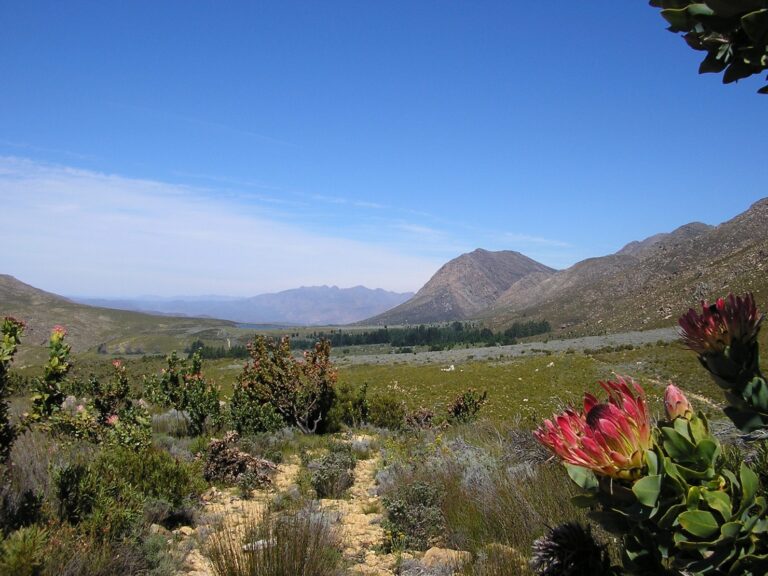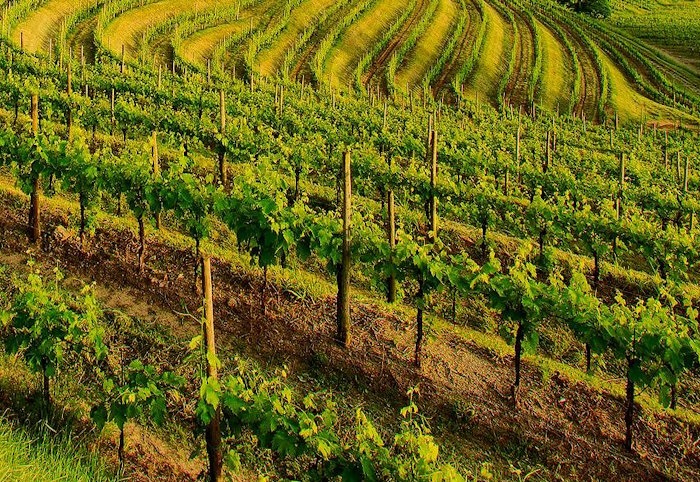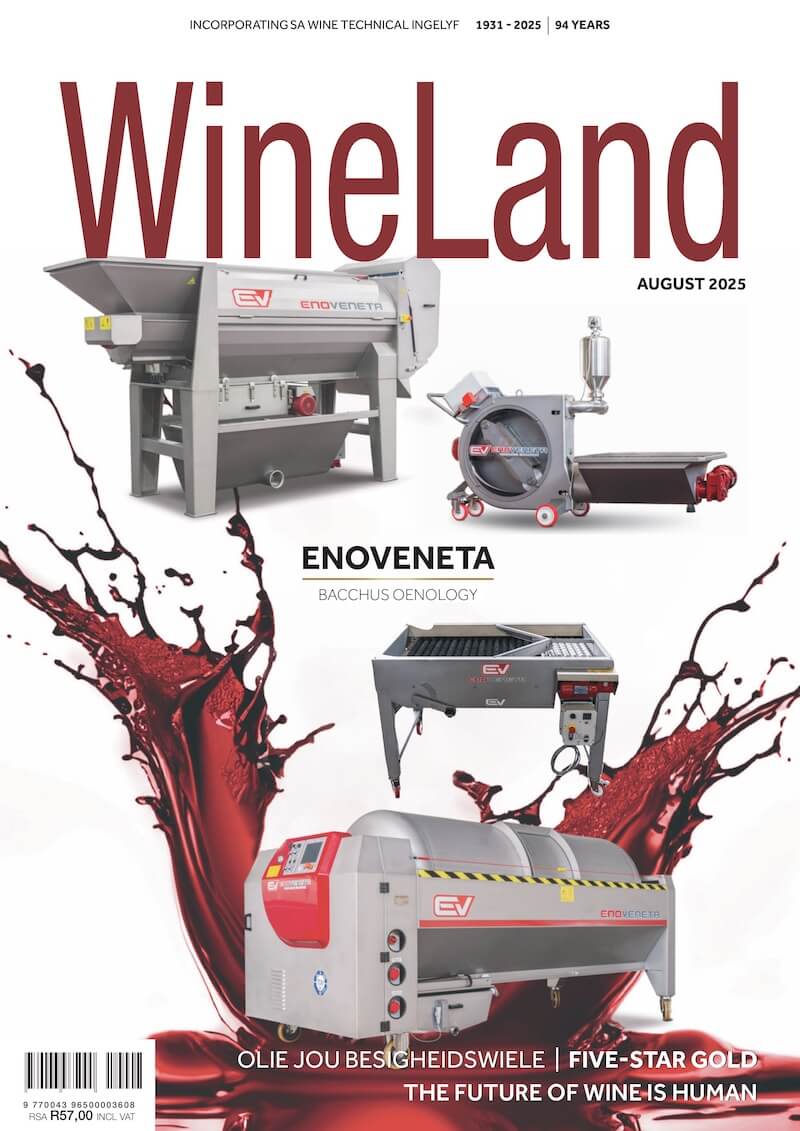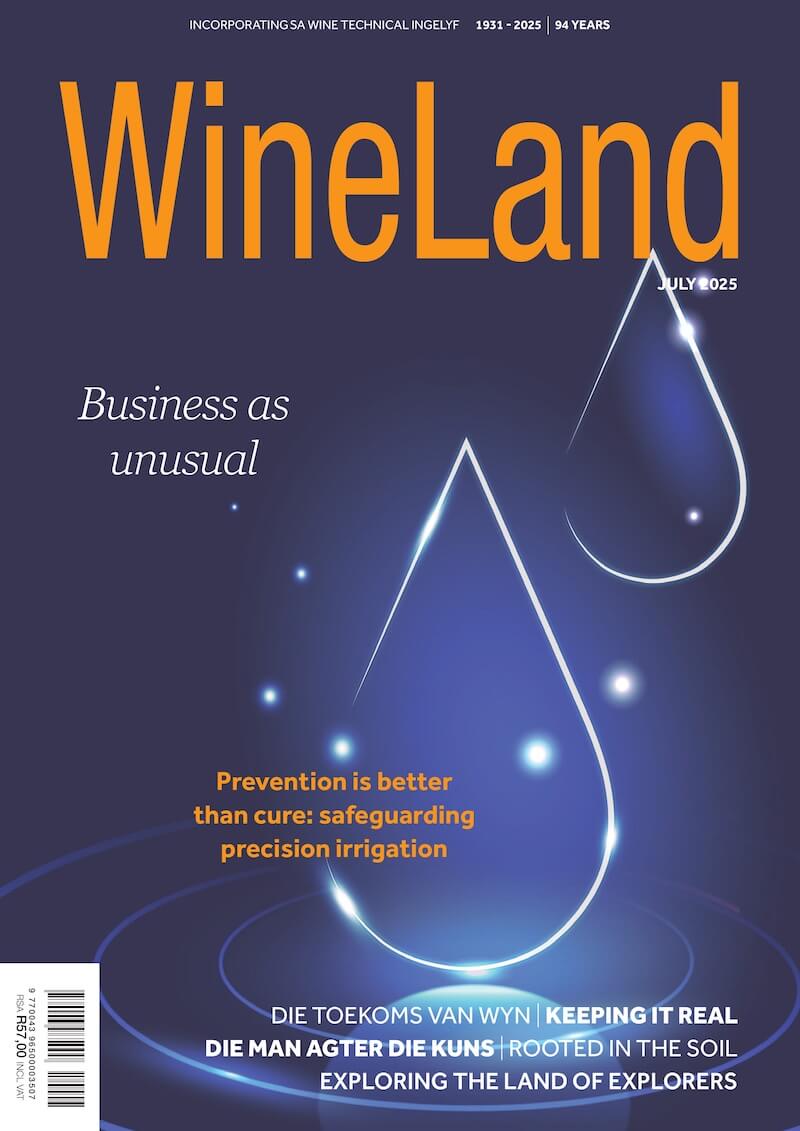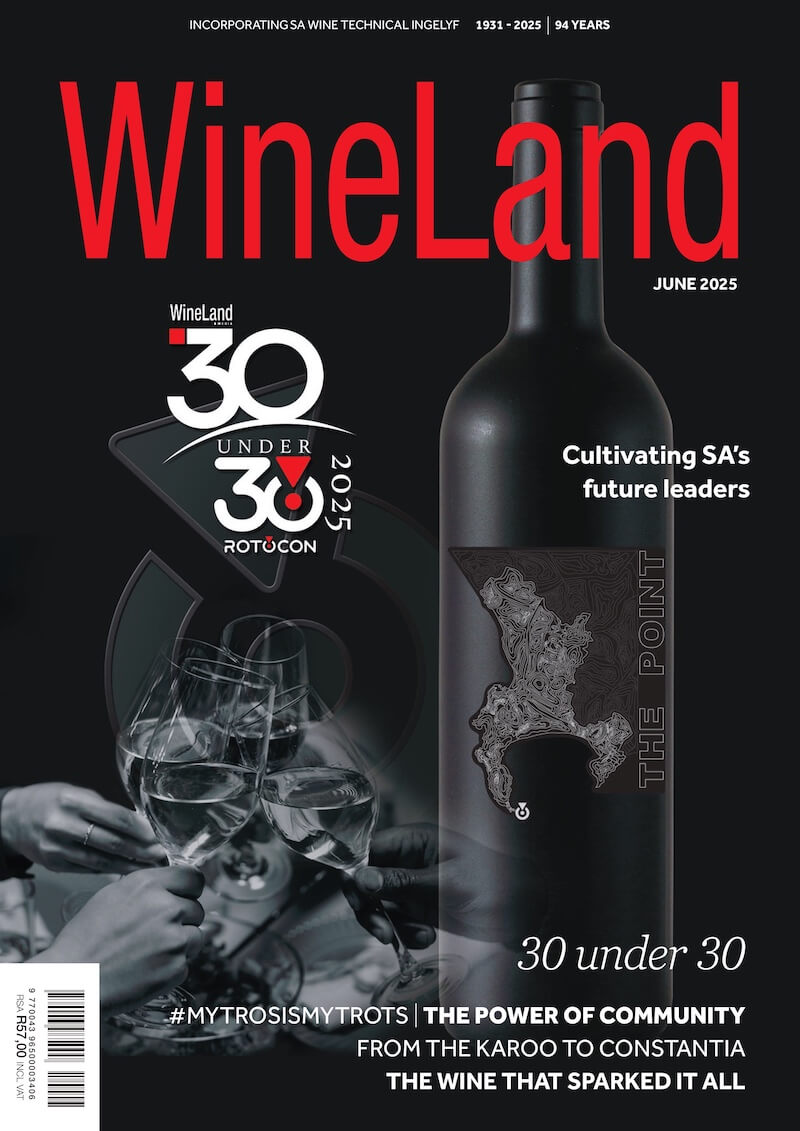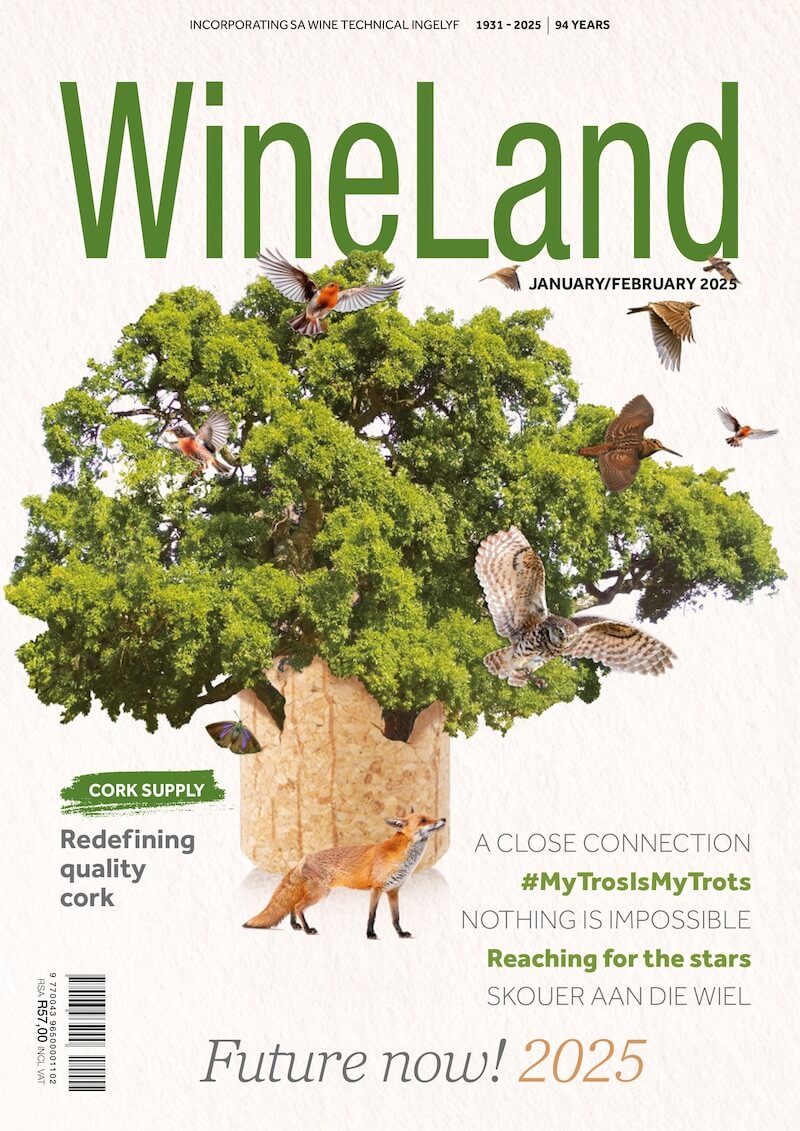Abstract
Although the effects of winery wastewater (WWW) on soil chemical properties have been the focus of some research, little is known about the effect of WWW on soil enzyme activity. Therefore, soils from four potential vineyard areas were irrigated, in pots, over four successive simulated seasons (SS), each consisting of six irrigation events, with municipal water and with WWW diluted to a chemical oxygen demand of 3 000 ml/L. Urease, β-glucosidase and phosphatase activities were determined in the 0-10 and 10-20 cm soil layers after the third and fourth SS. Compared with municipal water, irrigation with WWW increased the average activities of urease and β-glucosidase, but suppressed that of phosphatase. Using diluted WWW for irrigation increased urease and β-glucosidase activities in all four soils, increased β-glucosidase in the Stellenbosch shale and granite soils and decreased β-glucosidase activity in the Rawsonville sand. Compared with uncontaminated water from dams, rivers or boreholes, the effects of WWW on enzyme activity are therefore likely to differ from soil to soil and from enzyme to enzyme.
Introduction
Irrigation with wastewater, amongst other management practices,1 could change the internal soil environment in ways that affect the activities and functioning of microorganisms responsible for the breakdown of soil organic matter (OM), and for the mineralisation of nutrients.2 Enzyme activity may be stimulated through the change that might be due to stimulation of enzyme-producing soil microorganisms and, hence, enzyme activity, through the supply of easily decomposable organic material in wastewater, a process known as priming.3 Where enzymes are associated with and protected by soil colloids, they are likely to persist in soils for periods that exceed the lifespans of the microorganisms that produced them.4 The rates at which organic compounds break down are therefore likely to be more closely related to the abundance and activity of enzymes than to the numbers of microorganisms present.5
Urease is a soil enzyme that facilitates the hydrolysis of urea into NH3+ and CO2, increasing soil pH in the process.6 β-glucosidase, another soil enzyme, biodegrades carbon (C) compounds to form glucose, which is an energy source for the soil microbial population.7 β-glucosidase activity varies with soil OM content and type,8 and relates positively to water-soluble carbon, total organic carbon and pH.9 Phosphatases, on the other hand, facilitate the cycling of phosphorus (P).10 The activities of most soil enzymes are affected by factors such as soil OM content, cropping history, soil amendment applications and temperature.7 Enzyme activities reflect both short and long-term changes in their respective pools of substrates and products, and are considered to be useful indicators of soil health and fertility.11,12,13,14
To what extent enzyme activities change in response to the practice of irrigating with winery wastewater (WWW) under vineyard conditions in the Western Cape is nevertheless unknown, but it is likely that Western Cape soils will differ in their effects on enzyme activity. Taking above-mentioned into consideration, the objective of this study was to determine the effects of irrigation with diluted WWW on the activities of urease, beta-glucosidase and phosphatase of four soils varying in parent material and clay content.
Materials and methods
Experimental layout
Details of the pot experiment were given previously.15 In brief, a pot experiment was carried out under a 20 m x 40 m translucent fibreglass rain shelter at ARC Infruitec-Nietvoorbij. Four different soils, namely a Rawsonville sand, Lutzville sand, Stellenbosch shale and Stellenbosch granite, were included in the pot experiment. The control treatment soils were irrigated with municipal water. For the wastewater treatments, WWW was diluted to a chemical oxygen demand (COD) level of 3 000 mg/L.
Soil sampling and analyses
After SS3 and SS4, the soil material representing the 0-10 cm and 10-20 cm depth intervals from each pot was analysed in the ARC Infruitec-Nietvoorbij soil microbiology laboratory to determine the activities of β-glucosidase, acid phosphatase and urease. These two seasons were selected because it was assumed that a degree of equilibration between water and soil had taken place during the course of the preceding two simulated seasons. Enzyme activities were determined by the Soil Microbiological Laboratory at ARC Infruitec-Nietvoorbij according to methods described previously.15 Enzyme activities were expressed on a moisture-free basis. Soil moisture content was determined from the loss in weight after drying at 105°C for 24 hours.
Results
Urease
Urease activities in the 0-10 cm soil layer exceeded those in the 10-20 cm soil layer in all four soils (Figure 1). Average urease activity was generally greater in the third simulated season compared to the fourth one. Urease activities were higher in the soils irrigated with diluted WWW compared to those irrigated with municipal water in all four soils. Averaged over the two simulated seasons, water type and soil depth, urease activity in the soils decreased in the sequence Stellenbosch shale > Stellenbosch granite, Rawsonville sand > Lutzville sand (data not shown).

FIGURE 1. The effect of municipal water and winery wastewater (WWW) on the urease activity (μg NH4+ g/h) in four soils in the (A) 0-10 cm soil layer and (B) 10-20 cm soil layer in the third simulated season, as well as in the (C) 0-10 cm soil layer and (B) 10-20 cm soil layer in the fourth simulated season. Values in the same data set, that are followed by the same letter, do not differ at p = 0.05.
Phosphatase
Phosphatase activities in the 0-10 cm soil layer were similar to those in the 10-20 cm soil layer in all four soils (Figure 2). Average phosphatase activity tended to be greater in the third simulated season compared to the fourth one. Phosphatase activities were lower in the soils irrigated with diluted WWW compared to those irrigated with municipal water in all four soils. All-treatment average phosphatase activities decreased in the sequence: Stellenbosch granite > Stellenbosch shale > Rawsonville sand > Lutzville sand.

FIGURE 2. The effect of municipal water and winery wastewater (WWW) on the phosphatase activity (μg p-nitrophenol g-1 2h-1) in four soils in the (A) 0-10 cm soil layer and (B) 10-20 cm soil layer in the third simulated season, as well as in the (C) 0-10 cm soil layer and (B) 10-20 cm soil layer in the fourth simulated season. Values in the same data set, that are followed by the same letter, do not differ at p = 0.05.
β-glucosidase
β-glucosidase activities in the 0-10 cm soil layer tended to be greater than those in the 10-20 cm soil layer in all four soils (Figure 3). Average β-glucosidase activity was generally lower in the third simulated season compared to the fourth one. β-glucosidase activities were higher in the soils irrigated with diluted WWW compared to those irrigated with municipal water in all four soils. The β-glucosidase activities in the experimental soils decreased in the sequence: Stellenbosch shale > Stellenbosch granite > Rawsonville sand > Lutzville sand.

FIGURE 3. The effect of municipal water and winery wastewater (WWW) on the β-glucosidase activity (μg p-nitrophenol g-1 2h-1) in four soils in the (A) 0-10 cm soil layer and (B) 10-20 cm soil layer in the third simulated season, as well as in the (C) 0-10 cm soil layer and (B) 10-20 cm soil layer in the fourth simulated season. Values in the same data set, that are followed by the same letter, do not differ at p = 0.05.
Correlations and discussion
Urease activity correlated significantly with β-glucosidase activity but not with phosphatase activity (Table 1). β-glucosidase and phosphatase activities correlated significantly but not strongly.

Although the all-treatment average activities of the enzymes differed significantly between soils, the averages did not follow a consistent pattern (Figures 1, 2 and 3). Urease and β-glucosidase activities peaked in the Stellenbosch shale soil, whereas phosphatase activity peaked in the coarser-textured Stellenbosch granite soil. Nevertheless, the lowest activities of the three enzymes were all observed in the Lutzville sand which, like the Rawsonville sand, was dominated by the fine sand fraction.
Despite similarities in texture between the Rawsonville sand and Lutzville sand, their enzyme activities (Figures 1, 2 and 3) differed considerably. Texture does not have an overriding effect on enzyme activity, according to previous research that showed that in a population of 20 arid region soils, urease activity correlated with neither sand, silt, nor clay percentage.16 Whether the fact that the Lutzville sand was characterised by a lower initial organic carbon content and higher pH than the other experimental soils contributed to the low enzyme activities in Lutzville sand was unclear.
That urease correlated moderately well with glycosidase, and β-glucosidase correlated, though weakly, with phosphatase, whereas urease did not correlate with phosphatase (Table 1), implies that urease and phosphatase have different soil environmental requirements. Factors that correlate positively with urease activity include soil OM and total nitrogen contents.16 However, because all of the soils received WWW, and the WWW differed little in composition, the urease activities in the soils irrigated with WWW should have been similar, provided that the differences between soils were small. The fact that the urease activities in the WWW treatments differed between soils suggests that the effects of the soils on enzyme activity were large in comparison with those of the WWW. In the treatments irrigated with municipal water, urease activities did not differ significantly between soils, but the activities of both phosphatase and β-glucosidase were appreciably greater in the Stellenbosch shale and Stellenbosch granite soils than in the Rawsonville sand and Lutzville sand. That the Stellenbosch soils were initially more acidic and contained less exchangeable Ca than the Rawsonville sand and Lutzville sand may have contributed to the greater activities of β-glucosidase and phosphatase in the Stellenbosch soils following irrigation with municipal water is possible, but a pH effect seems improbable in view of the slightly alkaline pH (pH 7.4) of the municipal water.
The effect of water quality on enzyme activity was inconsistent, and the average urease (Figure 1) and β-glucosidase (Figure 3) activities were higher in the WWW than the MW treatments, whereas the converse was true for phosphatase (Figure 2). This supports the foregoing contention that enzymes differ in environmental requirements and implies that, compared with municipal water, WWW suppresses phosphatase activity. In the case of the Lutzville sand, differences in phosphatase and β-glucosidase activities due to water quality were not significant, but followed the same trend as the other soils, as was also the case for β-glucosidase in the Rawsonville sand. That both the Rawsonville sand and Lutzville sand were characterised by higher exchangeable Ca levels and higher pHs than the Stellenbosch soils may have contributed to the nonsignificant phosphatase activity responses observed in the Rawsonville sand and Lutzville sand. The tendency for WWW to promote urease and β-glucosidase activities and suppress phosphatase activity was consistent across the four different soils. Conceivably, soil phosphatase may require lower levels of P in the soil solution than are present in the WWW treatments to function effectively.
Average activities of urease and β-glucosidase were significantly greater, and phosphatase activity tended to be greater, in the 0-10 than the 10-20 cm depth interval. Assuming that the enzymes were uniformly distributed through the soil columns at the outset, this observation suggests either that the higher enzyme activity in the 0-10 cm horizon was due to enrichment of the 0-10 cm material with metabolisable substrate by the WW, relative to the 10-20 cm interval; that enzyme activity was suppressed in the lower regions of the pots, possibly by poor aeration; or by a combination of both factors. Previously, sample depth had little effect on organic C in any of the soils or water treatments.15 Neither did the cation exchange capacity differ greatly with depth, implying that depth-wise gradients in organic colloids had not developed. Better gas exchange in the 0-10 cm interval, therefore, appears to be a likely reason why enzyme activities were greater in the 0-10 cm than the 10-20 cm sample interval.
Conclusions
Compared with water from uncontaminated dams, rivers and boreholes, irrigation with diluted WWW is likely to promote the activities of urease and β-glucosidase, but suppress the activity of phosphatase, in most soils. This is likely to be especially the case in the superficial soil material. In soils that are sandy, mainly composed of fine to medium sand, and which are characterised by near-neutral or high pHs and reasonably high exchangeable Ca levels, irrigation with WWW had little or no effect on the activities of glycosidase and phosphatase. Such soils may nevertheless promote the activity of urease.
Acknowledgements
- This article is an output of WRC Project K5/1881, entitled “The impact of wastewater irrigation by wineries on soils, crop growth and product quality”. This solicited project was initiated, funded and managed by the WRC. The project was co-funded by Winetech and ARC.
- Goudini Winery for providing wastewater for the research.
- ARC for infrastructure and resources.
- Staff of the Soil and Water Science division at ARC Infruitec-Nietvoorbij for their assistance, and in particular Mr. F. Baron for his dedicated technical support.
References
- Floch, C., Capowiez, Y. & Criquet, S., 2009. Enzyme activities in apple orchard agroecosystems: How are they affected by management strategy and soil properties? Soil Biol. Biochem. 41, 61-68.
- Bardgett, R.D., Bowman, W.D., Kaufmann, R. & Schmidt, S. K., 2005. A temporal approach to linking aboveground and belowground ecology. Tends Ecol. Evol. 20, 634-641.
- Anissomova, M., Heinze, S., Chen, Y., Tarchitzky, J. & Marschner, B., 2014. Priming effects and enzymatic activity in Israeli soils under wastewater and freshwater irrigation. Geophysical Research Abstracts 16, EGU2014-3869-2, 2014. EGU General Assembly.
- Dick, R.P., 1994. Soil enzyme activities as indicators of soil quality. Defining soil quality for a sustainable environment. Madison, USA. pp. 107-124.
- Alexander, M., 1977. Introduction to soil microbiology. Wiley, New York.
- Andrews, R.K., Blakeley, R.L. & Zerner, B., 1989. Urease: a Ni (II) metalloenzyme. In: Lancaster, J.R. (ed). The bioinorganic chemistry of nickel. VCH, New York, pp. 141-166.
- Tabatabai, M.A., 1977. Effect of trace elements on urease activity in soils. Soil Biol. Biochem. 9, 9-13.
- Tabatabai, M.A., 1982. Soil enzymes In: Page, A.L., Miller, R.H. & Keeney, D.R. (eds.) Methods of soil analysis, Part 2. Chemical and microbiological properties 2nd ed., Madison, Wisconsin USA.
- Ma, X.Z., Chen, L.J., Wu, Z.J., Zhang, L.L. & Zhang, Y.L., 2010. Soil glycosidase activities and water soluble organic carbon under different land use types. R.C. Suelo Nutr. Veg. 10, 93-101.
- Speir, T.W. & Ross, D.J., 1978. Soil phosphatase and sulphatase. In: Burns RG (ed) Soil enzymes. Academic, London, UK, pp. 197-250.
- Bandick, A.K. & Dick, P.D., 1999. Field management effects on soil enzyme activities. Soil Biol. Biochem. 31, 1471-1479.
- Salam, A.K., Desvia, Y., Sutanto, E., Syam, T., Nugroho, S.G. & Kimura, M., 1999. Activities of soil enzymes in different land-use systems in middle terrace areas of Lampung province, South Sumatra, Indonesia. Soil Sci.Plant Nutr. 45, 89-99.
- Trasar-Cepeda, C, Leiros M.C. & Gil Sotres, F., 2000. Biochemical properties of acid soils under climax vegetation (Atlantic oakwood) in area of the European temperate-human zone (Galicia, NW Spain): Specific parameters. Soil Biol Biochem 32, 747-755.
- Madejon, E., Burgos, P., Lopez, R. & Cabrera, F., 2003. Agricultural use of three organic residues: effect on orange production and on properties of a soil of the Comarca Costa de Huelva (SW Spain). Nutrient Cycling in Agroecosystems 65, 281-288.
- Mulidzi, A.R., 2016. The effect of winery wastewater irrigation on the properties of selected soils from the South African wine region.D. dissertation. Stellenbosch University, Private Bag X1, 7602 Matieland (Stellenbosch), South Africa.
- Noorbakhsh, F., Hajrasuliha, S. & Emtiazy, G., 2001. Factors affecting urease enzyme activity in some soils of Isfahan Province. J. Sci. Technol. Agric. Nat. Res. 5, 95-106. Abstract viewed at http://jstnar.iut.ac.ir/browse.php?a id=67&sid=1&slc lang=en on 30 March 2015 at 21:00.
For more information, contact Reckson Mulidzi at mulidzir@arc.agric.za.
Click here to get your copy of WineLand Magazine.
